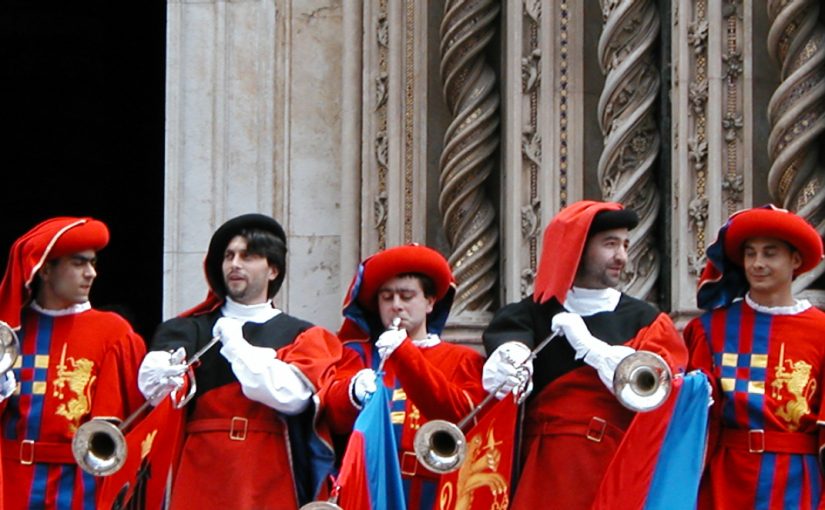Today was Palombella. I walked to Piazza del Duomo at about nine this morning, to pay my respects more than anything. The cathedral’s central doors were open, and the square was empty except for two men walking separately towards the steps. They were both in black, but more police black that clerical black. I paused for awhile, then moved on. To see that much open space on a festival day made me sad.
Palombella is a celebration of Pentecost. In Orvieto’s traditional ceremony, the Holy Spirit is represented by a while dove that is sent flying from a cluster of painted clouds above the nearby church of Saint Francis to travel down a wire and into a painted wooden tower erected on the steps of the Duomo. The creature’s arrival is greeted by clouds of colored smoke and mini-Roman candles above cutout representations of Mary and the Apostles to indicate tongues of flame. The main event is surrounded by pageantry derived from a mix of periods from the medieval onward. It is all very historic and wonderfully charming. It is also, among the many religious festivals that are woven into Orvieto’s cultural fabric, the longest observed, predating the Duomo by centuries and with possible roots in pre-Christian practice.
You don’t mess with Palombella without good reason.
This year the dove was replaced by a drone that flew the route normally taken down the wire. And that’s all I know for sure. There were no painted clouds, no tower or Apostles, no drums, no trumpets, no periwigged footmen to deliver the dove to Oriveto’s newest wed. In short, nothing was there to attract onlookers. Perhaps for the same reason, the shape and timing of the drone event remained vague. I checked the papers, I asked many people, I learned little. In a way, it was an elegant solution. The tradition was upheld in its intention, and manifested in a mode that discouraged onlookers and respected public health.
This evening I stopped at Trattoria dell’Orso for soup. Stefano and I got to talking, and of course, Palombella quickly offered itself as a topic of conversation.
“You know, all this makes me sad,” Stefano said, waving his left hand towards the street.
“Yeah, me too.”
“The economic situation worries us, but it’s not that. To me, Orvieto is a place for art and music, festivals and markets, people from all over the world flooding the streets. All gone. Except for we who live here – and only mornings and evenings – the streets and plazas are almost empty. That’s what makes me sad. I miss the joy, the company, the many languages, the different races.”
I nodded and repeated his lament. We stood together for a moment of silence.
“This will pass. But it reminds you of how fragile it all is. Even after a thousand years.”
But everywhere I wandered last night, groups of people with ladders were hanging flags, or were on their balconies draping banners. The festival of flowers, Orvieto in Fiori, that usually includes floral tapestries in churches, and baskets of flowers hanging from walls, was along with everything else that would draw crowds, regretfully cancelled. But baskets of flowers in the quartiere’s colors were up just the same. Life goes forward, regardless.
Today, there were tourists, probably from other parts of Umbria, as inter-regional travel is still restricted. They must have been from out of town because no one local would bother with such photographic equipment (or carry maps) that early in the day. Others without cameras (or maps) had that lovely dreamily lost look that the best of tourists frequently display. It expresses an admirable willingness to give up the familiar and let the senses come alive in unexpected ways. It was good to see them. They are our guests. They validate the town’s finest qualities. They remind us that its culture and traditions will persist.
Later in the day, I revisited Piazza del Duomo and sat for awhile in the shadow of its temple. Small groups of young people sat on the lawn, dotted the steps, and crossed the piazza. The central doors were closed. An older couple, snugly masked, meandered hand in hand, and sent up a glance towards the mosaics and carvings from time to time. The afternoon sun caught the gold woven artfully into the tiled murals and twisted columns. The facade is a kind of festival of its own. For now, it will more than suffice.
The photo is of Palombella trumpeters, 2002.
